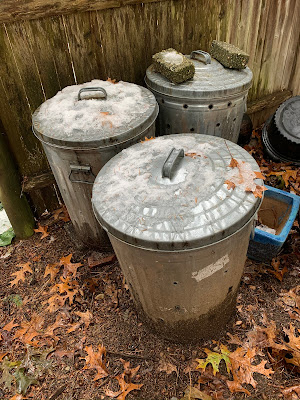To meet my environmental goals, I’ve been avoiding peat-based potting mixes and trying to cut down on buying plastic pots. As I plan next year’s garden, I’m thinking about how I can move this campaign up a notch.
 |
| Starting to envision spring lettuce |
Now that I know that peat is a non-sustainable resource, I’ve turned to coconut fiber, or coir, as the key ingredient in my seed-starting mix. I can live dangerously and use my homemade potting mix, which is half coir and half sifted compost from my compost bins. That mix isn’t weed-free or sterile.
 |
| Coir and compost mix ready for summer containers |
Or I can buy coir-based products such as Organic Mechanics Seed Starting Blend, made of coconut coir, pine bark, rice hulls, and worm castings, with no peat. This mix is pretty easy to find, and it works well for me.
The next problem is the containers. I’ve got a collection of plastic six-packs for seedlings. Some I bought new—regrettably, I now feel. Others came with seedlings I bought at garden centers.
 |
| A lifetime supply of seedling six-packs |
I’ve washed and reused these, often through more than one seed-starting cycle. Eventually they tear and have to be discarded.
Last year I reached a turning point in my thinking about plastic pots. For years, the “green industry”—the businesses that produce and sell garden plants—have chosen plastic containers for their low cost, durability, and light weight. Now the industry can’t easily pivot to other materials, because they’ve designed their machines around the plastic pots’ sizes, shapes, and other physical properties. If they’d make a start, though, I bet lots of consumers like me would be willing to pay a few extra cents for non-plastic containers.
 |
| Even my local native plant shop uses plastic pots |
I was heartened by a recent Fine Gardening article about biocontainers. The writer, University of Georgia professor Bodie Pennisi, describes two types of biodegradable pots: plantable pots made of recycled paper plus or minus dehydrated cow manure, and compostable pots made from pressed coir.
 |
| Coir pots |
These are relatively durable and neat-looking. A more ephemeral product is a paper sleeve made from wood fibers that lasts long enough to contain flower and vegetable starts.
Like me, you may have tried starting seeds in flats and pots made of pressed peat. I found these didn’t decompose as advertised. I plan to try starting seedlings in CowPots this year. These are the brainchild of a Connecticut farmer who’s been producing them from homegrown cow manure for 20 years. They’re said to keep their integrity for 12 weeks above ground. After planting, they should break down in one growing season, allowing roots to penetrate easily. The nitrogen in the decomposing cow manure reportedly gives the young plants a boost.
 |
| CowPots at Gardener's Supply |
For perennial divisions, I’d prefer longer lasting containers. I’m going to try pressed coir pots. I see that I can buy some from Greenhouse Megastore or Gardener's Supply, if not at my local garden center. I’ll report back on how these products work out.
Now, how to do we get the garden industry to make the switch too?


















































